Selection of alkali liquid regulating valve in chlor-alkali chemical industry
Posted by Bundor valve
As the core equipment for controlling the flow and pressure of alkali liquid, the selection and use of alkali liquid regulating valve directly affect production efficiency and safety.

I. Selection principles of alkali liquid regulating valve
1. Flow characteristics: According to the process requirements, select a regulating valve with a linear, equal percentage or fast opening characteristic curve to ensure that the flow can be accurately controlled under different working conditions.
2. Pressure and temperature range: The alkali liquid in the chlor-alkali chemical process is usually under high temperature and high pressure conditions, so the pressure level and temperature range of the regulating valve must meet the process requirements.
3. Flow capacity: The flow capacity (Cv value) of the regulating valve is calculated based on the flow and pressure loss of the alkali liquid in the pipeline system.
II. Material selection of alkali liquid regulating valve
1. Valve body material: Since alkali liquid is highly corrosive, the valve body material must have excellent corrosion resistance. Common materials include stainless steel, alloy steel and lining materials (such as PTFE, PVC, etc.).
2. Internal material: The internal parts of the valve (such as valve core and valve seat) are in direct contact with alkali solution, and corrosion-resistant and wear-resistant materials such as stainless steel, Hastelloy, monel, etc. need to be selected.
3. Sealing material: The material of the sealing part needs to have good corrosion resistance and sealing performance. Commonly used materials include PTFE, fluororubber, graphite, etc.
III. Use and maintenance of alkali solution regulating valve
1. Installation: The installation position of the regulating valve should be convenient for operation and maintenance. During installation, it is necessary to ensure that the valve is concentric with the pipeline to avoid stress concentration.
2. Debugging: After installation, the regulating valve needs to be debugged to check whether its action is normal and whether the flow and pressure control meet the design requirements.
3. Maintenance: Regularly check the operating status of the regulating valve, including whether the valve is flexible, whether the seal is good, and whether the internal parts are worn.
The selection and use of alkali solution regulating valve directly affects the stability and safety of the chlor-alkali chemical process.

I. Selection principles of alkali liquid regulating valve
1. Flow characteristics: According to the process requirements, select a regulating valve with a linear, equal percentage or fast opening characteristic curve to ensure that the flow can be accurately controlled under different working conditions.
2. Pressure and temperature range: The alkali liquid in the chlor-alkali chemical process is usually under high temperature and high pressure conditions, so the pressure level and temperature range of the regulating valve must meet the process requirements.
3. Flow capacity: The flow capacity (Cv value) of the regulating valve is calculated based on the flow and pressure loss of the alkali liquid in the pipeline system.
II. Material selection of alkali liquid regulating valve
1. Valve body material: Since alkali liquid is highly corrosive, the valve body material must have excellent corrosion resistance. Common materials include stainless steel, alloy steel and lining materials (such as PTFE, PVC, etc.).
2. Internal material: The internal parts of the valve (such as valve core and valve seat) are in direct contact with alkali solution, and corrosion-resistant and wear-resistant materials such as stainless steel, Hastelloy, monel, etc. need to be selected.
3. Sealing material: The material of the sealing part needs to have good corrosion resistance and sealing performance. Commonly used materials include PTFE, fluororubber, graphite, etc.
III. Use and maintenance of alkali solution regulating valve
1. Installation: The installation position of the regulating valve should be convenient for operation and maintenance. During installation, it is necessary to ensure that the valve is concentric with the pipeline to avoid stress concentration.
2. Debugging: After installation, the regulating valve needs to be debugged to check whether its action is normal and whether the flow and pressure control meet the design requirements.
3. Maintenance: Regularly check the operating status of the regulating valve, including whether the valve is flexible, whether the seal is good, and whether the internal parts are worn.
The selection and use of alkali solution regulating valve directly affects the stability and safety of the chlor-alkali chemical process.
 简体中文
简体中文 Русский
Русский Español
Español Bundor - Butterfly, Gate, Check, Ball, Globe Valve Manufacturer, Supplier & Distributor
Bundor - Butterfly, Gate, Check, Ball, Globe Valve Manufacturer, Supplier & Distributor
